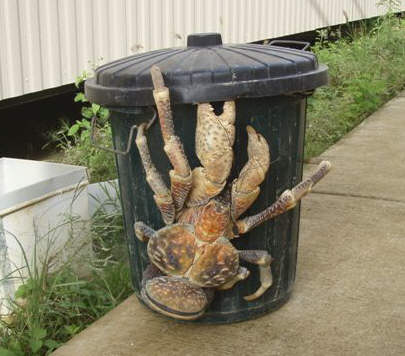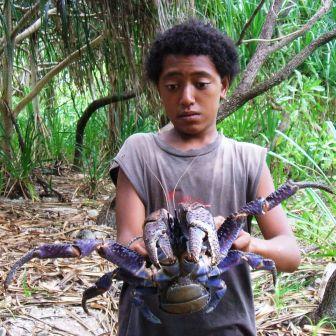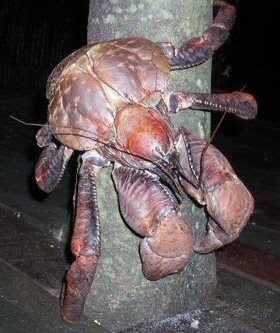So, let’s start this all off by showing you the picture that piqued (I fear this far too subdued a word) my interest:
Snopes.com has listed the authenticity of this photo as “partly true” as they haven’t been able to authenticate the origins of the photo, but as I’ll explain, it’s well within the realm of believability.
These guys are known by multiple names including coconut crab due to their ability to crack coconuts with their claws to access the meat inside, robber crab due to their alleged propensity to steal shiny objects, as well as palm thief. Their range is associated with coasts of the Pacific and Indonesian Oceans.
They are considered the largest land-dwelling arthropods, apparently pushing the size limits of terrestrial organisms with exoskeletons. I did a little digging and it appears there are two possible reasons for this. The most cited reason is the oxygen content of the air. Animals with exoskeletons have a tougher time with gas exchange through their hard shells and need to devote a fair amount of surface area to the deed. The bigger they become the harder this task becomes (See this ScienceDaily article for more on this). While I’m not sure how valid the second conjecture is in this particular case, I found the suggestion that the weight of the exoskeleton eventually becomes too much to bear for large land-bound crabs as compared to aquatic species. This is certainly true for animals like whales that start to suffer from their weight on land when stranded, I’m just not sure how much this is true for coconut crabs. They can have leg spans reaching up to 3 ft which is one reason that 1st startling picture seems possible (although I found quite a bit of arguing online about several elements of the photo that might suggest it has been photo-shopped, not the least of which includes the unlikelihood of this species to be roaming around during the day as it tends to get too hot for them).
They are definitely considered generalists and will go after a large variety of food. It seems this means mostly fruit and plants but apparently also means turtle hatchlings, rats, and sometimes dead things. I can’t relay the horror I feel at the citation in the wikipedia article indicating coconut crabs may have eaten Amelia Earhart’s body or at least dragged her bones off. It can at least be said then, that coconut crabs can hardly be called discerning creatures.
As adults, these animals have no natural predators save the locals who savor them as a delicacy as well as an aphrodisiac. This little crab fetish has actually given the crabs worldwide protected status. As perhaps a karmic payback of sorts, there have been cases of food poisonings from dining on the crabs related to their occasionally toxic diets.
So don’t say I never taught you anything…



Hi, that photo is genuine, some contractors took that photo when working out at the detention centre on Christmas Island. It’s certainly the largest i’ve seen but there are many close to it’s size. They do come out if they smell food…day or night! And the detention centre is surrounded by forest so it probably wasn’t a big trip for this big fella.
Do you live out there? Interesting to get some validation about the photo. I would get a kick out of seeing these things lumbering around…
hi there, that picture of that coconut crab is true.. I live in guam and I think that is the same coconut crab that is on display at the university.. My friend’s brother was one of the guys that found it in the wild and donated it to the university.. The university then went ahead and preserve the crab.. it is still on display at the university of guam agriculture and wild life department.. the crab was already preserve when that picture was taken, they are just showing everyone how big it is.. The crab is dead so it doesn’t mind being out in the sun, that’s why some sceptic believe it’s a fake because they rarely come out during the day .. A crab that big can easily pick me up and start walking while I am standing on top of it, and I am 180lbs.. I know some people that have caught a coconut crab, put it inside a dog cage, and wake up the next morning to find the cage rip wide open and the crab gone..
I caught one baby crab (11 inches) by chance last night.. It was just crawling on the road, scared it might get run over or eaten, I picked it up and took it home.. I’ll raise it for a couple of weeks then release it in a wild life refuge..
Hi, thanks for taking the time to give some feedback. I think these guys are extremely fascinating but it’s always interesting tracking down authentic information. They must be pretty amazing to see alive and kicking in the wild. Also interesting that you got the opportunity to interact with a little guy. It’s looks like guam has some pretty cool wildlife.